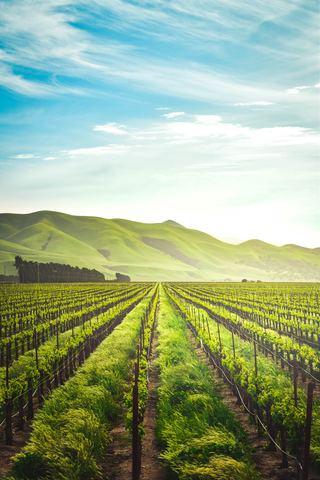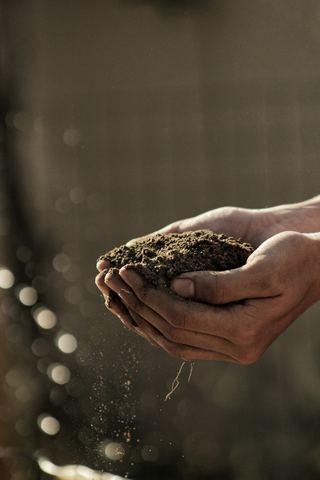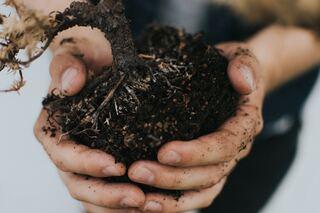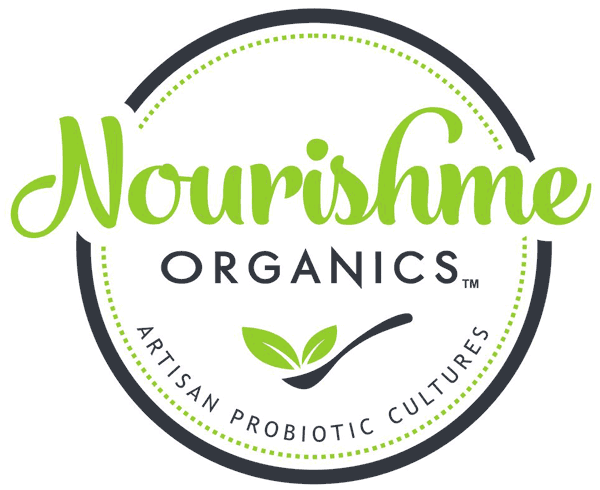Masa Depan Pertanian: Probiotik Tanah

Saya senang bisa berbicara dengan Jock Leys. Jock tumbuh di sebuah pertanian di Wales Utara. Ia belajar ilmu pertanian di Universitas dan selalu bekerja di bidang pertanian. Minatnya adalah bidang biologi dan bergerak melampaui cara-cara pertanian tradisional. Saat ini kita mengetahui efek samping pestisida yang berbahaya. Masalahnya adalah pestisida membantu menghasilkan lebih banyak tanaman. Namun, bagaimana jika ada sesuatu yang dapat melakukan ini secara alami? Baca terus untuk mempelajari tentang bakteri dan tanaman, bakteri usus dan bakteri tanah, mikoriza dan bagaimana mikoriza membantu kebun Anda, serta cara-cara untuk meningkatkan kebun Anda sehingga Anda dapat menanam semua sayuran Anda sendiri tanpa efek samping yang berbahaya!

Bagaimana Penggunaan Pupuk Sintetis, Fungisida, dan Insektisida Dimulai?
Ketika pertanian menjadi terindustrialisasi, sistem yang kita miliki semakin tertekan. Ketika kita harus menanam tanaman secara intensif dari tahun ke tahun, muncullah berbagai masalah. Misalnya: Jika Anda menanam gandum dari tahun ke tahun, penyakit yang dapat menyerang tanaman dan membunuh tanaman Anda akan semakin umum. Itulah masalah utama yang perlu mereka atasi. Beginilah asal mula fungisida, insektisida, dan pupuk.
Ketika Anda bercocok tanam tahun demi tahun, Anda mengambil banyak nutrisi dari tanah . Para petani ini membutuhkan sesuatu untuk mengembalikan nutrisi tersebut. Pada saat itu, pengembangan pestisida ini berjalan dengan baik. Pestisida ini memungkinkan kita memenuhi permintaan dan memungkinkan makanan kita tumbuh tanpa penyakit. Ada sebuah buku yang berjudul " The Silent Spring". Salah satu poin utama buku ini adalah tentang bahan kimia pada masa lalu yang hanya mengisi kekosongan untuk masalah yang mereka hadapi seperti:
Serangga yang memusnahkan hutan di Amerika Utara
Tanaman kapas sedang dimusnahkan
Beberapa tanaman pangan terbesar di dunia mengalami masalah
Lalu tiba-tiba ditemukan bahan kimia yang dapat mengatasi masalah tersebut. Namun, 5-10 tahun kemudian mereka mulai menyadari bahwa masalah lain sedang terjadi. Burung dan ikan diburu secara massal. Pertanian modern kini mencoba menghindari masalah ini dan bahan biologis sangat aman dan dapat menyelesaikan masalah. Begitulah pestisida muncul dan bagaimana bahan biologis membuka jalan menuju pilihan yang lebih berkelanjutan.

Bakteri Usus dan Organisme Tanah
Tanah apa pun yang Anda ambil akan memiliki jutaan mikroorganisme berbeda di dalamnya dan semuanya bereaksi dengan cara yang berbeda. Kita mulai memahami beberapa interaksi utama yang sedang berlangsung, kita masih harus menempuh jalan panjang untuk memahaminya sepenuhnya. Ini adalah lingkungan yang sangat kompleks. Pada awalnya, kita berasumsi bahwa semua organisme di dalam tanah bersifat merugikan dan menyebabkan penyakit. Namun dalam beberapa tahun terakhir dengan semua penelitian tentang mikrobioma, kita menemukan bahwa sebagian besar bakteri ini baik untuk kita .
Tujuan saya adalah mengembalikan kesadaran itu. Penting untuk menumbuhkan ekosistem yang sehat, baik ekosistem usus maupun tanah . Bagian penting dari perbaikan masalah pencernaan adalah memperbaiki tanah. Karena banyak bakteri baik akan berawal dari tanah dan berakhir di usus kita serta membantu sistem pencernaan sesuai kebutuhan. Bakteri baik juga akan membantu mengatasi penyakit modern yang saat ini kita hadapi. -Kriben Govender
Kita tahu tanaman memiliki kemampuan alami untuk mengatasi penyakit yang dihadapinya, baik itu:
Tanah
Dedaunan
Serangga menyerang
Persaingan dari gulma
Banyak dari kemampuan ini yang berhubungan dengan hubungan simbiosis dengan mikrobioma yang hidup di tanah.
Misalnya: Kemampuan tanaman untuk mengatasi penyakit umum akan meningkat jika tanaman memiliki hubungan yang lebih kuat dengan bakteri utama yang hidup di dalam tanah. Kita mulai memahami bakteri mana yang penting bagi hubungan tersebut. Setelah mengetahui hal ini, kita perlu memeriksa tanah dan melihat apakah bakteri tersebut ada di sana. Jika tidak ada, kita dapat memasukkannya ke dalam sistem dan meningkatkan kemampuan tanaman untuk mengatasi masalah yang dihadapinya secara alami sejauh menyangkut produktivitas . Jika Anda memahami semua ini dengan benar, Anda mungkin masih memerlukan kimia sintetis sesekali tetapi ketergantungan Anda akan jauh lebih sedikit.
Ada begitu banyak hubungan timbal balik antara bakteri usus kita dengan jamur dan ragi tanah. Saya tahu ketika saya pergi ke kebun, saya yakin saya mendapatkan cukup banyak probiotik hanya dengan menggali tanah -Kriben Govender

Apakah Tanaman Itu Sendiri Berkomunikasi dengan Bakteri Tanah?
Ya, benar, dengan menggunakan Mikoriza. Mikoriza adalah sejenis jamur. Jamur ini membentuk hubungan yang menguntungkan dengan akar tanaman. Mikoriza telah ada selama jutaan tahun. Jamur ini telah berevolusi hingga memiliki hubungan simbiosis dengan sebagian besar tumbuhan di bumi. Para ahli berpendapat bahwa 90% tumbuhan memiliki hubungan simbiosis dengannya.
Kita tahu bahwa agar mikoriza dapat berkoloni, tanaman perlu memberi sinyal. Tanaman menyambutnya ke dalam akar dan mengirimkan sinyal yang mengatakan bahwa ia siap untuk berkoloni. Ada banyak alasan mengapa tanaman dapat memberi sinyal atau tidak. Kita perlu menemukan cara agar kita dapat mendorong hal ini terjadi . Mikoriza adalah sesuatu yang merespons dengan baik sinyal tanaman. Dalam beberapa kasus, mikoriza akan meningkatkan kemampuan tanaman untuk mengambil kelembapan dan nutrisi di dalam tanah hingga 100x . Mikoriza membantu tanaman mengakses semua manfaat di dalam tanah yang jika tidak demikian akan sulit mereka dapatkan. Ini menguntungkan tanaman dalam banyak hal termasuk: 1. Membantu menarik nutrisi (nutrisi yang tidak bergerak!) seperti fosfor, seng, dan magnesium. Ini semua tidak bergerak di dalam tanah jadi kecuali akar tanaman bergesekan dengannya, mereka tidak akan mengambilnya. Tetapi begitu jamur yang bermanfaat tumbuh di dalam tanah dan begitu ia tumbuh ke akar, ia akan menariknya kembali. Ia bertindak seperti perpanjangan dari akar tanaman. 2. Membantu membawa lebih banyak kelembapan ke tanaman. Apa pun yang membantu tanaman mengambil kelembapan akan membantu. Ekstensi ekstra yang dibentuk mikoriza di ujung akar akan sangat membantu. 3. Ada 7 kategori utama mikoriza tetapi ada ribuan spesies individu yang berbeda. Bergantung pada spesies itu, mereka dapat membantu membentuk hifa jamur pelindung di sekitar akar, mengurangi dampak jamur negatif. Tanaman yang memiliki kolonisasi mikoriza yang baik cenderung tidak terpengaruh oleh penyakit . Mikoriza menghasilkan zat berbasis karbon lengket yang mereka sekresikan ke dalam tanah. Ini kaya akan karbon dan jika Anda menguji tanah Anda setiap tahun dan Anda memiliki kolonisasi yang baik, kadar karbon Anda akan meningkat dari tahun ke tahun. Ini bagus untuk tanah yang sehat. Zat globulin lengket membantu agregasi tanah. Ini membantu menjaga partikel tanah tetap bersatu.
Apakah Ada Penelitian yang Memvalidasi Jamur Mikoriza?
Telah dilakukan penelitian di Oregon dan kami juga melakukan penelitian di Australia. Kami memastikan bahwa apa yang telah ditemukan di luar negeri berhasil di Australia. Selama beberapa tahun terakhir kami telah mereplikasi 30 uji coba lapangan di berbagai bagian negara. Dengan spesies pohon dan tanaman yang berbeda. Kami mulai melakukan banyak penelitian ini dan telah mendapatkan hasil yang positif. Kami tidak selalu mendapatkan hasil yang bagus, ini adalah situasi yang rumit. Kami baru-baru ini menerima hasil panen kentang. Sebuah perkebunan kentang menanam kentang mereka secara tradisional dan kami meminta petani untuk menginokulasi dengan inokulan mikoriza empat galur kami dengan benih kentangnya saat ia menanam. Petani itu mendapat peningkatan hasil panen sebesar 10% . Secara teori, mikoriza ini seharusnya membawa cukup nutrisi sehingga Anda tidak memerlukan pupuk. Dalam kasus ini itulah yang terjadi. Ini adalah kemenangan bagi petani dan lingkungan. Produk mikoriza yang kami miliki akan membayar sendiri 100x lipat.

Bagaimana Orang Menemukan Mikoriza?
Ketika pertanian mulai menjadi industri, orang-orang membicarakan sesuatu yang disebut gangguan bera panjang. Bera panjang didefinisikan sebagai "menjaga tanah tetap kosong sebelum menanam tanaman." Mereka menyadari bahwa jika Anda memasukkan bera ke dalam siklus tanam Anda, Anda mungkin menanam lebih sedikit tanaman tetapi Anda akan menghasilkan tanaman yang lebih baik. Bera panjang berarti membiarkan ladang Anda tidak berproduksi. Jika Anda melewatkan satu tahun, Anda akan mengalami:
-Lapangan yang semakin basah
-Nutrisi akan mengalami mineralisasi
-Sampah apa pun punya peluang untuk terurai
-Nutrisi menjadi lebih mudah diserap tubuh.
Mereka menyadari hal ini sehingga mereka memperkenalkan periode bera ini hingga mereka melakukannya terlalu lama. Inilah yang kami sebut bera panjang. Mereka mencoba mengumpulkan lebih banyak air sehingga saat Anda menanam tanaman, Anda memiliki cukup air untuk menumbuhkannya. Namun setelah lebih dari 12 bulan, efek sebaliknya mulai terjadi dan mereka tidak tahu mengapa. Yang terjadi adalah mereka menghabiskan mikoriza . Mikoriza membutuhkan inang hidup di dalam tanah agar dapat bertahan hidup . Anda dapat memiliki gulma, tetapi di Australia, lebih banyak petani tidak akan menoleransi gulma sehingga sama sekali tidak ada yang dapat dimakan mikoriza ini.
Mereka kemudian mencoba menanam tanaman di area tersebut dan ternyata tanaman itu tidak sehat. Mereka mencoba memberi banyak pupuk, tetapi tanaman itu tidak dapat mengaksesnya tanpa bantuan mikoriza. Para ilmuwan pada tahun 1930-an mulai meneliti mengapa hal ini terjadi dan mereka mengidentifikasi mikoriza sebagai alasan mengapa tidak ada yang tumbuh.
Apakah Ada Batasan dalam Penggunaan Jamur Mikoriza?
90% dari semua spesies tanaman membentuk hubungan dengan mikoriza dalam beberapa cara. Beberapa sangat bergantung dan tanpanya, tanaman tidak akan tumbuh subur. Beberapa di antaranya meliputi:
-Tomat
-Kapas
-Jagung
Yang lain dengan hubungan yang kurang kuat:
-Gandum
-Hampir tidak
Beberapa dari 10% tanaman lainnya yang tidak membutuhkan mikoriza adalah:
-Lobak
-Kacang kanola
- Kubis
-Bunga Lupin
Ini hanyalah contoh, tetapi sebagian besar tanaman tumbuh subur jika memiliki hubungan dengan mikoriza. Ada keterbatasan untuk semuanya, tetapi itu jauh lebih bermanfaat daripada sekadar membatasi.

Bagaimana Menurut Anda Perkembangan Produksi Mikoriza di Masa Depan?
Butuh waktu lama untuk memahami spesies ini sepenuhnya dan kita masih mempelajari seberapa pentingnya spesies ini bagi beberapa tanaman dibandingkan tanaman lainnya. Beberapa penelitian yang telah dilakukan dalam 10 tahun terakhir lebih penting daripada penelitian sebelumnya. Butuh waktu lama untuk mendapatkan kekuatan.
Jika kita kembali ke tahun 1950-an ketika pupuk sintetis diperkenalkan, orang-orang memperoleh peningkatan hasil panen hingga 50% dengan menggunakan pupuk super . Hal ini mengalahkan semua hal lainnya. Sekarang kita memahami semuanya dan kita telah memeras semua peningkatan produktivitas dari sebagian besar produk. Kita sekarang mulai menyempurnakannya, dan saya yakin penyempurnaan ini akan datang dari bahan-bahan biologis.
Saya berharap pertanian modern mempertimbangkan keinginan konsumen untuk menginginkan lebih banyak produk alami. Produk yang berkelanjutan, baik untuk planet ini, dan sesuatu yang akan melindungi planet ini ke depannya. Alih-alih produk yang diproduksi dengan bahan kimia. -Kriben Govender
Manfaat lingkungan adalah kuncinya. Di daerah tempat tebu ditanam, ada banyak perhatian pada pencucian pupuk nitrogen yang masuk ke terumbu karang penghalang besar. Mereka ingin melakukan apa pun yang mereka bisa untuk mengurangi pupuk sintetis di sana. Beberapa penelitian mikoriza/tebu menunjukkan hasil positif. Jika mereka dapat menghilangkan pupuk ini, itu akan mengurangi tekanan pada terumbu karang! Masa depan tampak cerah untuk mikoriza...
Apakah Ada Produk Baru Lainnya di Bidang Biologi?
Banyak produk yang merupakan bakteri. Bakteri yang bermanfaat sama banyaknya dengan jamur. Namun, ada juga banyak bakteri yang merugikan. Untuk setiap bakteri atau jamur yang merugikan, ada bakteri atau jamur yang bermanfaat…..
+Streptomyces telah berevolusi selama bertahun-tahun untuk memiliki hubungan yang menguntungkan dengan tanaman.
-Nematoda adalah cacing mikroskopis di dalam tanah dan sebagian besarnya memiliki dampak negatif. Mereka mengambil nutrisi dari tanah yang merampas produktivitas tanaman.
TETAPI ada beberapa jenis bakteri yang kami temukan yang menekan bakteri tersebut (dan penyakit tanah!) dan mengurangi dampaknya pada tanaman . Ketika melihat bakteri baik, bakteri tersebut perlu berkoloni dan berkembang biak secara melimpah. Bakteri tersebut perlu mencapai tingkat tertentu dan mencapai akar. Bakteri tersebut mungkin tidak membunuh penyakit tetapi akan menyerangnya dan mendorongnya menjauh dari akar dan memungkinkan tanaman tumbuh jauh dari penyakit.
Seperti probiotik untuk tanah. Kita tahu bahwa ia juga memiliki aplikasi untuk dedaunan. Anda dapat menyemprotkannya pada tanaman jika tanaman tersebut terserang penyakit seperti embun tepung atau penyakit daun. Ini akan membantu menekan penyakit tersebut. Bahan biologis ini lebih baik untuk lingkungan.

5 Tips untuk Tukang Kebun Pemula
1. Produk kami tersedia DI SINI . Mulailah memahami bahwa Anda dapat meningkatkan kadar alami bakteri dan jamur baik ini tanpa harus menginokulasinya. NAMUN inokulasi itu mudah, Anda hanya perlu menaruhnya di benih saat Anda menanam atau menyiramnya ke dalam tanah. Jika Anda memahami bahwa mikoriza lebih mungkin berkoloni pada spesies tertentu, Anda dapat menanamnya di kebun sayur Anda dan Anda dapat meningkatkan kadarnya secara alami. Ingatlah bahwa jika Anda membiarkan area itu kosong terlalu lama, Anda akan menghabiskan kadar mikoriza. Mulailah membuat organisme baik bekerja sesuai keinginan Anda!
2. Pastikan untuk menjaga kadar bahan organik tetap tinggi. Beberapa tanaman hidup dari bakteri atau jamur hidup dan beberapa hidup dari bahan organik mati. Jika Anda menyimpan sebanyak mungkin jaringan tanaman mati dan memasukkannya kembali ke dalam tanah, itu akan membantu tanaman tumbuh subur. Cobalah untuk memelihara tanaman di kebun Anda sebanyak mungkin. Dengan cara ini bakteri dan jamur yang baik akan memiliki tempat untuk hidup. Anda juga dapat menambahkan mulsa dan daun ke kebun Anda. Itu akan membangun bahan organik.
3. Anda juga bisa menguji tanah Anda. Kami melihat parameter uji tanah dan mengukur karbon organik. Anda bisa memesan uji mikrobioma tanah Anda sendiri DI SINI . Ini akan sangat membantu Anda untuk melihat apakah Anda berada di jalur yang benar. Bagi tukang kebun pemula, cobalah mencium bahan organik di dalam tanah, lihat organisme yang lebih besar seperti cacing yang aktif, maka Anda berada di tempat yang baik tetapi jika Anda menginginkan hasil yang lebih akurat, Anda bisa mengujinya.
4. Teliti mikoriza dan lihat tanaman mana yang terbantu. Lihatlah tabel dan lihat spesies apa yang harus ditanam di kebun sayur Anda untuk membantu meningkatkan kadarnya.
5. Mulailah dengan hal-hal seperti mengomposkan sisa-sisa sayuran, ini akan membantu kebun Anda dan mengurangi sampah yang dibuang ke tempat pembuangan sampah. Mulai membuat tempat pengomposan, memulai peternakan cacing, semua orang dapat membantu menjadikan planet ini tempat yang lebih baik.
Bakteri dan jamur adalah masa depan pertanian. Ada banyak alternatif alami yang dapat kita terapkan untuk diri kita sendiri dan lingkungan kita. Mulailah menanam di kebun Anda lebih sering, ingatlah bahwa bakteri tanah akan menjadi bakteri usus, tingkatkan persediaan jamur mikoriza di tanah Anda, dan uji tanah Anda sehingga Anda tahu bahwa tanaman Anda akan tumbuh subur. Bagikan ini dengan teman-teman Anda yang juga tukang kebun, selamat berkebun!












